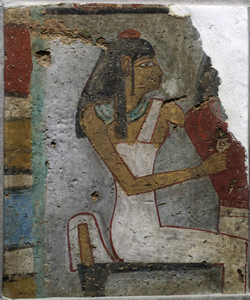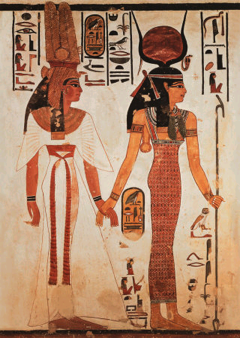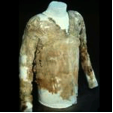Linen- the heart of fashion in Ancient Egypt
Ahhh, linen. It is beautiful, versatile, durable and luxurious. It is no wonder that the Ancient Egyptians, rich and poor alike, prized it above all other fabrics. The hot climate of Egypt made lightweight clothing mandatory and linen offered the perfect solution. The flax could be woven into a fine weave that kept the wearer cool, a must in the hot Saharan desert. Egyptian weavers were skilled at their craft. They were able to produce linen cloth that was so sheer and delicate it was almost like gauze.

In stark contrast to the elaborate Egyptian costumes worn by Elizabeth Taylor in Cleopatra, Egyptian fashion was actually amazingly simple. It changed very little through 3,000 years of rule. The few new styles that were introduced were simply worn alongside existing dress. The same basic styles were worn by most Egyptians. The quality of the fabric reflected social position; the finest linen, woven with gold threads was worn by the Pharaoh. It is said that Cleopatra VII, who possessed a legendary wardrobe, wore linen dresses that were woven with gold. Slaves and commoners, on the other hand, wore loincloths made from coarse linen or leather.
Until the Eighteenth Dynasty (New Kingdom), most Egyptian women wore the kalasiris, a simple linen sheath that usually fell from below the breasts to just above the ankles. It could be held up by shoulder straps or sleeves.
The kalasiris is traditionally depicted in paintings as a very tight, form fitting garment, but some dispute has been raised about how accurate those depictions are. According to some archaeologists, in reality, the kalasiris was probably more loose and flowing.

This not only would have allowed for greater ease of movement but would have kept Egyptian women cooler in the hot climate. Others say that there is no reason to assume the paintings are inaccurate and that the kalasiris was probably as tight fitting and quite possibly as sheer as the tomb paintings illustrate. Surviving pieces show the kalasiris was essentially a length of linen sewn down one side to create a tube. A shawl could be worn to protect the skin from the sun or on cooler winter nights for warmth. During the Eighteenth Dynasty, the wives of the nobility and the pharaoh, such as Nefertiti, the wife of Akhenaton, are depicted in new, more elaborate fashions. The new garments were long, flowing robes of linen so fine that it was almost transparent and covered in dainty accordion pleats. The kalasiris was sometimes worn underneath these robes, but sometimes the robe was worn by itself.
The basic staple of men’s clothing was a linen kilt called a schenti. Much like the women’s kalasiris, the schenti kept the same basic shape for 3,000 years. The schenti was a rectangle of knee length linen cloth that wrapped around the waist and fastened in the front by overlapping and tucking the ends. Like women’s garments, paintings depict more elaborate men’s dress during the New Kingdom. This new costume consisted of a pleated schenti and a long, sheer, pleated robe. Another option was made up of the schenti, a transparent overskirt and a collarless shirt with wide, pleated sleeves.

Most Egyptians wore white linen clothing for functional as well as symbolic reasons. For the Egyptians, white symbolized happiness, so they were content to wear clothing of this color. Though the Egyptians did develop methods of dying linen different colors, it was a difficult process because linen did not readily absorb the natural dyes. For this reason, most clothing was made from bleached linen.
Linen is so durable and the Egyptian climate is so wonderful for preservation that quite a lot of clothing from Ancient Egypt has been discovered. Sir William Flinders Petrie discovered the oldest surviving dress in the world in a First Dynasty tomb at Tarkhan. It is 5,000 years old! It is made of intricately pleated linen and gives some example of the fine workmanship of Egyptian weavers. The dress is now on display at the Petrie Museum in London.

The Ancient Egyptians were masters at creating beautiful garments that have literally stood the test of time. When you start choosing items to add to your summer wardrobe, consider adding a few more linen pieces. After all, with proper care (and just the right conditions) those pieces could last 5,000 years!






























































3 Comments
Karen Blackburn
Great article. It’s interesting to note that Wallace E Budge wrote in one of his books at the end of the 19thC that he personally doubted that the dresses worn by the women of Egypt were as tight to the body as shown in the paintings. He favoured the view that this would make them totally unsuitable for daily wear as it is impossible to do more than walk with tiny steps when the clothing is this tight. I’ve tried it in a dress made this way and I can attest to his common sense views, I couldn’t even sit down in the dress. I also note that the Petrie museum notes that 2 of the dresses they have are purely for wear by the dead because the skirt is tight to the figure, implying that it would have totally unsuitable for daily life. I completely agree with the comments on historical clothing and the awards won, they should really be won for clothing that totally misrepresents that which was worn in the era of the film. If they have no problem showing topless sunbathers in films/TV series then they should have no problem showing actresses wearing the egyptian dresses with the straps and exposed breasts, or wearing dresses sheer enough that the body can be seen clearly through the fabric. Incidentally, given that egyptian medicine was rather advance for the time I strongly suspect that they were well aware that allowing ones skin free access to the sun, which is strong there, resulted in burning and, at the very least, pain if not blistering etc. As a result I imagine that coverings were worn, even if they were just shawl like upper body garments, and I also suspect that the striped head covering shown in many pictures and statues was worn as much to protect the head and back of the neck from the sun as anything else. They weren’t stupid, and given that they had no problem with others moving to the country and taking up residence, implying that as a result they could well have had residents whose skins were not suited to the environment from birth, I feel that they almost certainly covered up in daily life, even if this isn’t shown on statues or in paintings. Even today there are many items of wear not shown in paintings or modern statues such as sun hats and the lightweight caftans etc. worn on beaches and the like. Future studies may well wonder what we wore in similar conditions in the same way we wonder what was worn daily 5000yrs ago.
B SInger
I find this very interesting and refreshing, in part because of how obviously incorrect the portrayal of Egyptian clothing is in the movies (along with that of every other era for that matter). It is nice to see a source that does not try and apply modern era “body shame” issues to what ought to be a discussion of fact (as it really was).
We live in an are in which movie actors are willing to appear totally nude (at length) for any sexual reason, but when the reason for showing ones body (sheer clothing, low cut, etc) is simply “historically accurate clothing”, censorship, the fetishisation of nudity and “body shame” kick in. And so we have the odd curiosity of costumers receiving awards for historical costume dramas, in which the costuming is very very wrong. We have movies where the Egyptians, Greeks, and even the people of the Medieval and Empire Eras, are wearing utterly incorrect clothing (censored for modern sensibilities). For example, the younger women of status are always portrayed wearing clothing with the ‘concealing’ bust line that was reserved for the elderly. How is being that far from historical reality a thing one ought to get an award for? Showing at least the uper portion of the bust line “pink bits” was the normal reality for a very long time, yet people do not know because even historical references on fashion are censored so as not to offend people…just as references on animal life used to censor out the reality of homosexual activity in other species (which is actually quite common) and how “Grays Anatomy” censored out several parts of the female reproductive system in the latter part of the 20th century (all the bits that are there to cause pleasure were removed from print for several decades…and some are still missing form the diagrams).
Thank you for being honest. Most people in this era have no idea how odd (and atypical) our modern ‘cover it up’ attitude toward fashion and the human body really is.
Andy
Ancient fashion clothing and accessories have an interesting history.
It is also interesting to note the development of gloves as a practical accessory that became a fashion essential.
Linen Gloves were found in Ancient Egypt in the tomb of King Tut so they have been used for centuries.
There’s an interesting resource that provides information on the origins and evolution of gloves called the History of Gloves It has lots of interesting information about the evolution and development of gloves. Worth a read if you like gloves me-thinks.
http://www.goleathergloves.com/history-of-gloves.htm